Changes in PRIMAP-hist v2.6_final compared to v2.5.1_final for Israel
2024-09-24
Johannes Gütschow
Change analysis for Israel for PRIMAP-hist v2.6_final compared to v2.5.1_final
Overview over emissions by sector and gas
The following figures show the aggregate national total emissions excluding LULUCF AR6GWP100 for the country reported priority scenario. The dotted linesshow the v2.5.1_final data.
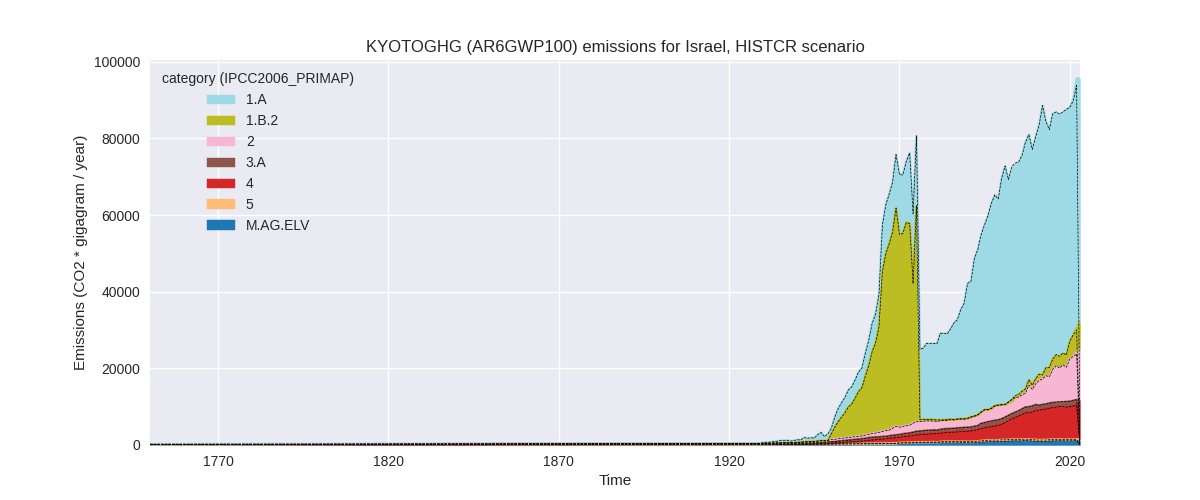
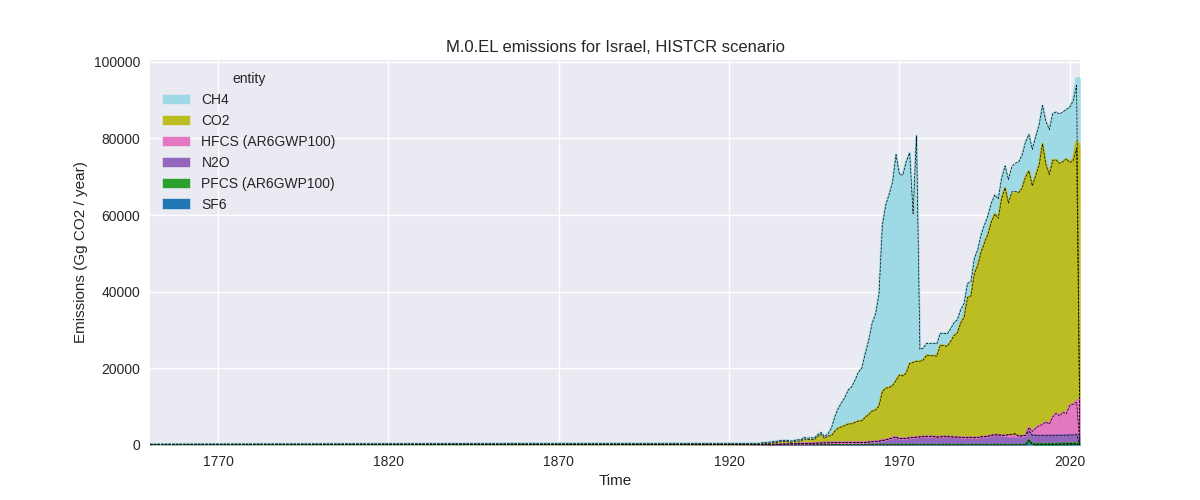

The following figures show the aggregate national total emissions excluding LULUCF AR6GWP100 for the third party priority scenario. The dotted linesshow the v2.5.1_final data.
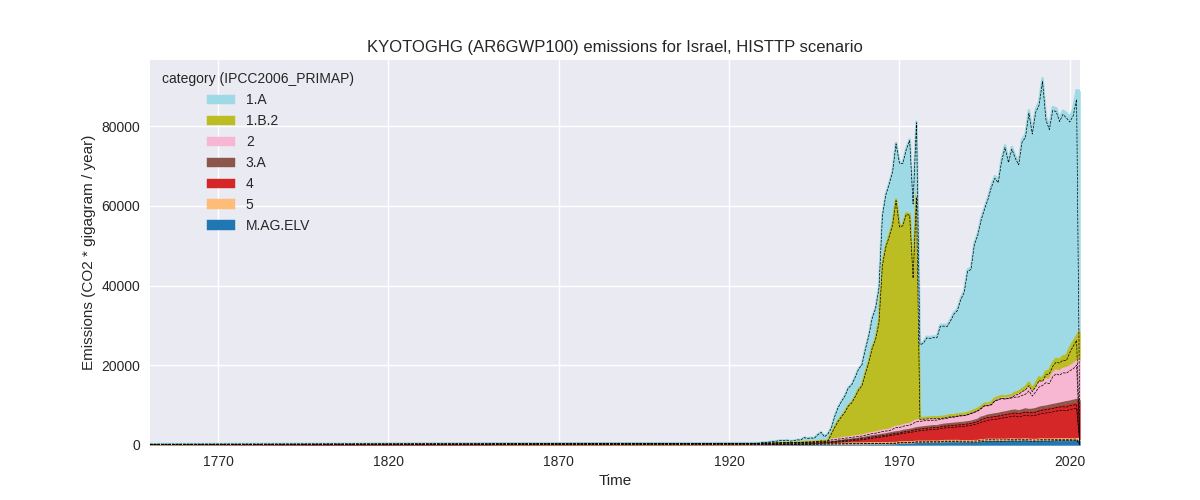
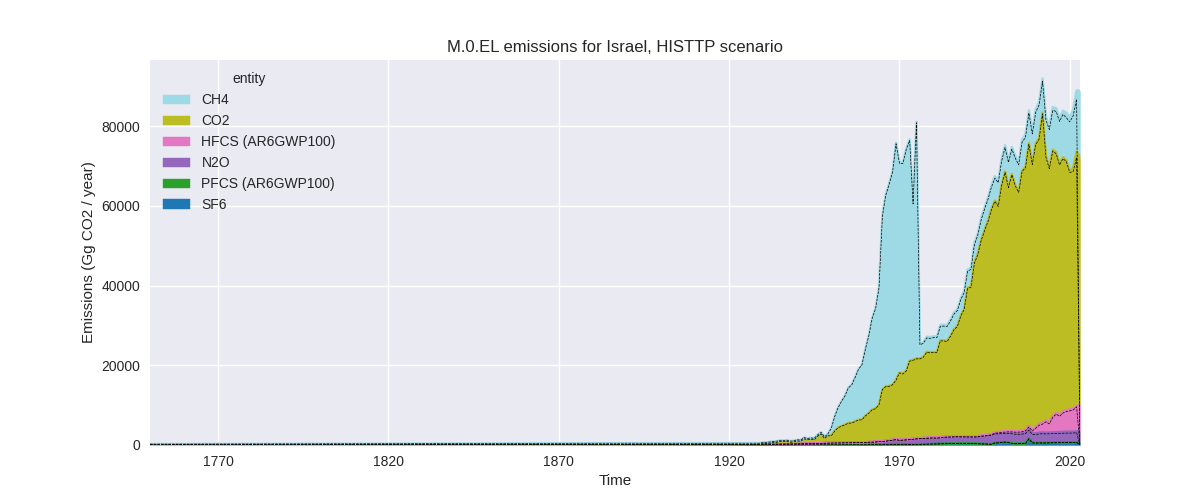
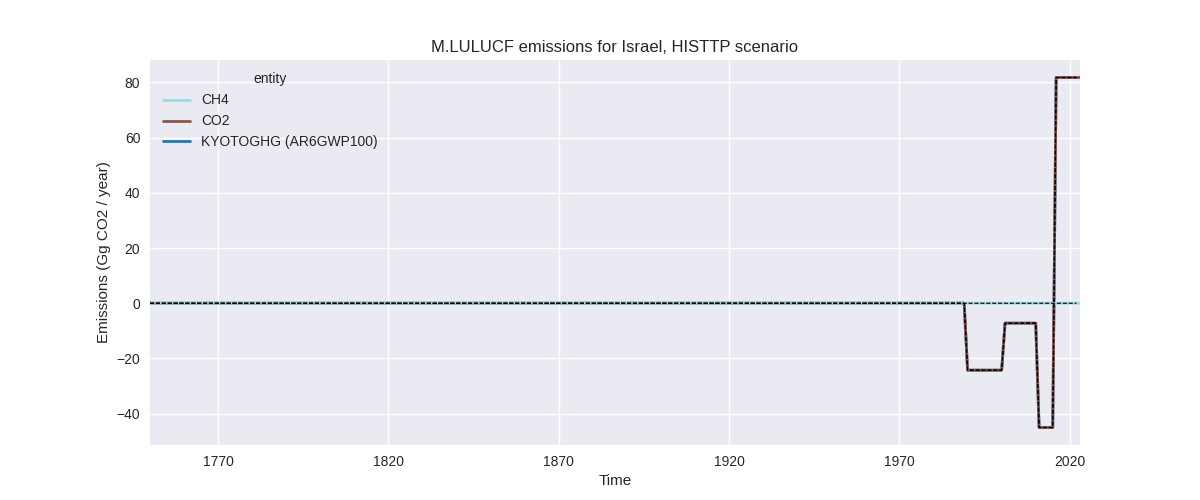
Overview over changes
In the country reported priority scenario we have the following changes for aggregate Kyoto GHG and national total emissions excluding LULUCF (M.0.EL):
- Emissions in 2022 have changed by 1.8%% (1734.69 Gg CO2 / year)
- Emissions in 1990-2022 have changed by -0.0%% (-11.23 Gg CO2 / year)
In the third party priority scenario we have the following changes for aggregate Kyoto GHG and national total emissions excluding LULUCF (M.0.EL):
- Emissions in 2022 have changed by 2.6%% (2277.89 Gg CO2 / year)
- Emissions in 1990-2022 have changed by 1.0%% (746.54 Gg CO2 / year)
Most important changes per scenario and time frame
In the country reported priority scenario the following sector-gas combinations have the highest absolute impact on national total KyotoGHG (AR6GWP100) emissions in 2022 (top 5):
- 1: 1.A, CO2 with 1433.18 Gg CO2 / year (2.3%)
- 2: 2, HFCS (AR6GWP100) with 333.80 Gg CO2 / year (4.0%)
- 3: 5, N2O with -34.22 Gg CO2 / year (-10.4%)
- 4: 2, PFCS (AR6GWP100) with -25.62 Gg CO2 / year (-9.6%)
- 5: 2, SF6 with 17.92 Gg CO2 / year (12.2%)
In the country reported priority scenario the following sector-gas combinations have the highest absolute impact on national total KyotoGHG (AR6GWP100) emissions in 1990-2022 (top 5):
- 1: 1.A, CO2 with 61.39 Gg CO2 / year (0.1%)
- 2: 2, N2O with -43.72 Gg CO2 / year (-7.0%)
- 3: 5, N2O with -22.90 Gg CO2 / year (-6.8%)
- 4: 4, CH4 with -20.09 Gg CO2 / year (-0.3%)
- 5: 2, HFCS (AR6GWP100) with 10.12 Gg CO2 / year (0.5%)
In the third party priority scenario the following sector-gas combinations have the highest absolute impact on national total KyotoGHG (AR6GWP100) emissions in 2022 (top 5):
- 1: 1.A, CO2 with 1353.90 Gg CO2 / year (2.3%)
- 2: 4, CH4 with 725.81 Gg CO2 / year (9.8%)
- 3: 4, N2O with 393.65 Gg CO2 / year (130.0%)
- 4: 2, HFCS (AR6GWP100) with -185.79 Gg CO2 / year (-2.9%)
- 5: 5, N2O with -34.22 Gg CO2 / year (-10.4%)
In the third party priority scenario the following sector-gas combinations have the highest absolute impact on national total KyotoGHG (AR6GWP100) emissions in 1990-2022 (top 5):
- 1: 4, CH4 with 421.95 Gg CO2 / year (7.4%)
- 2: 4, N2O with 277.22 Gg CO2 / year (124.9%)
- 3: 1.A, CO2 with 57.99 Gg CO2 / year (0.1%)
- 4: 5, N2O with -22.90 Gg CO2 / year (-6.8%)
- 5: 2, HFCS (AR6GWP100) with -5.63 Gg CO2 / year (-0.3%)
Notes on data changes
Here we list notes explaining important emissions changes for the country. ’' means that the following text only applies to the TP time series, while means that it only applies to the CR scenario. Otherwise the note applies to both scenarios.
- We have no new country reported data for Israel.
- Energy CO2 emissions are higher in 2020 because EI2024 shows higher emissions than EI2023
- 2022 F-gas emissions are impacted by changed extrapolation trend periods.
- Changes in sectors 4 and 5 are due to the removal of FAOSTAT data (CR (5 only), TP).
Changes by sector and gas
For each scenario and time frame the changes are displayed for all individual sectors and all individual gases. In the sector plot we use aggregate Kyoto GHGs in AR6GWP100. In the gas plot we usenational total emissions without LULUCF. ## country reported scenario
2022
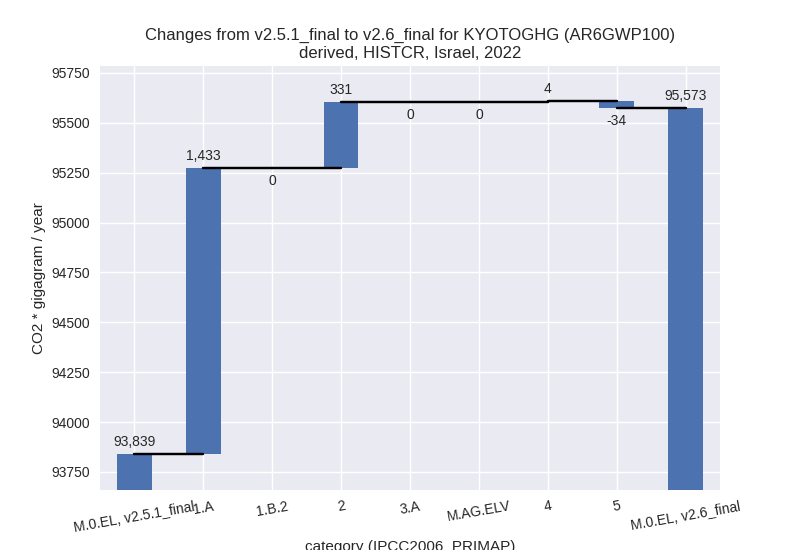
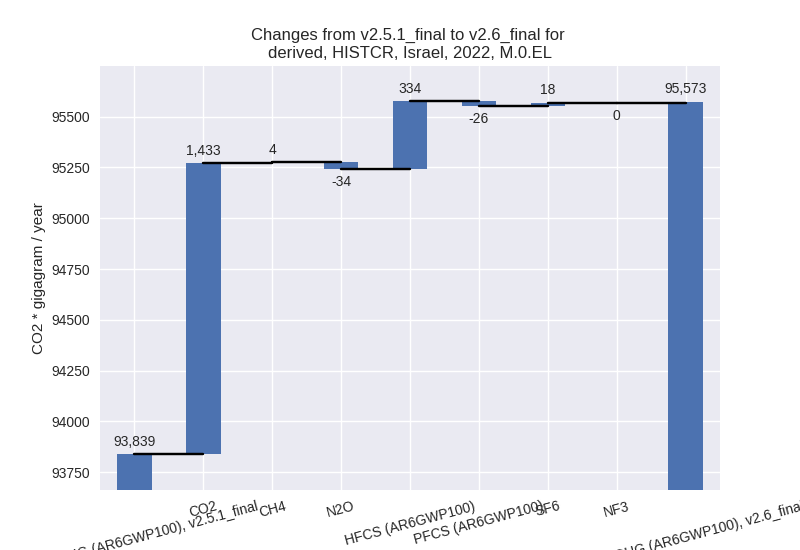
1990-2022
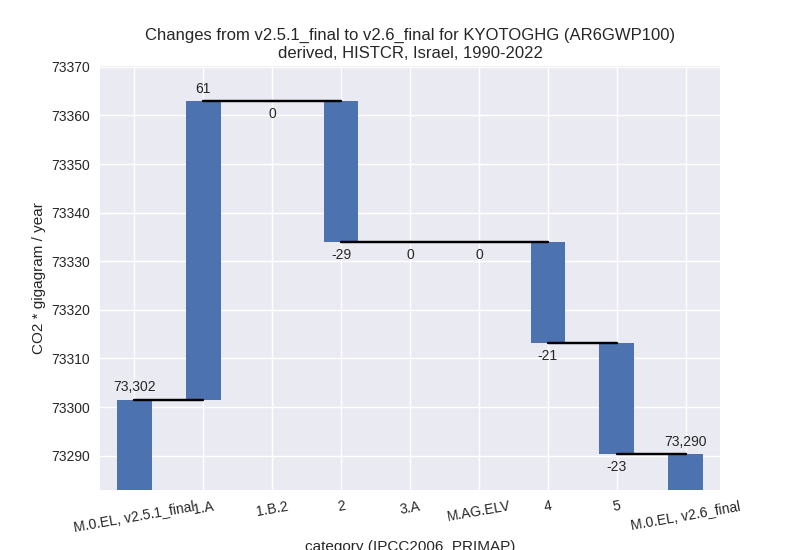
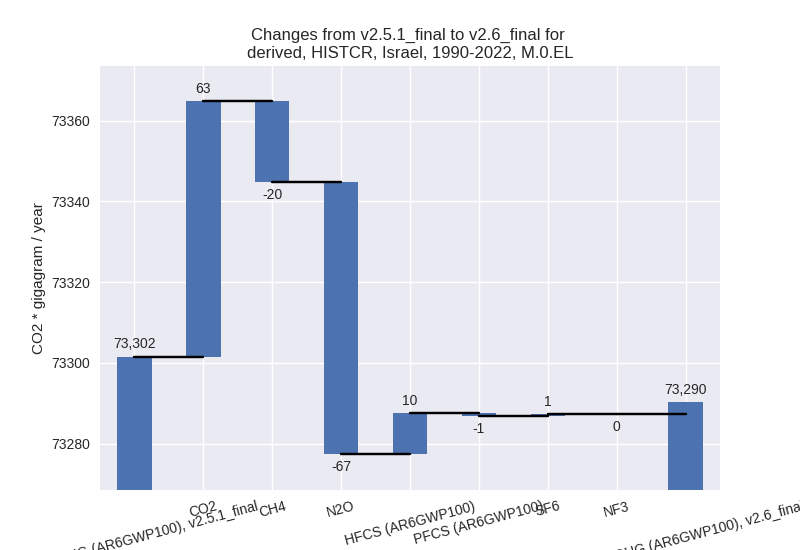
third party scenario
2022
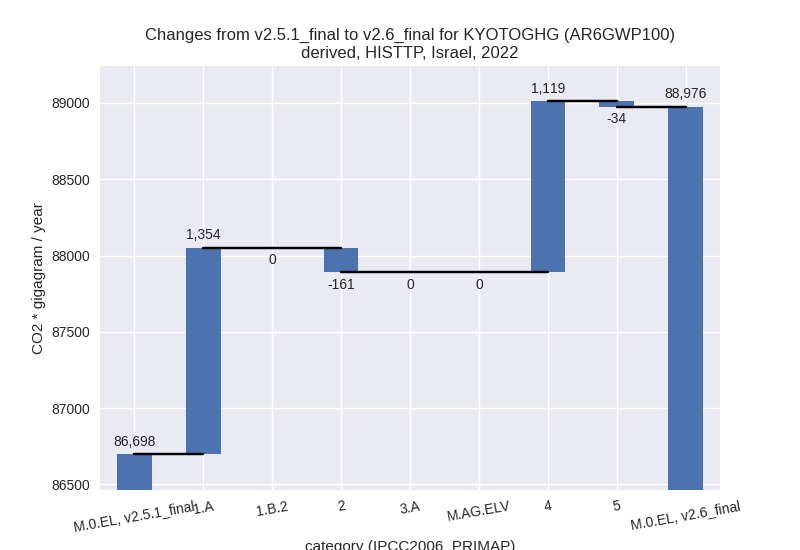
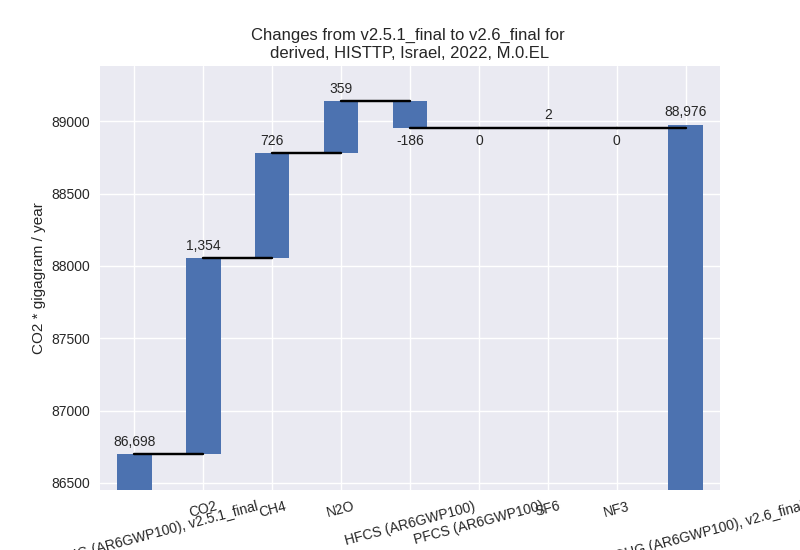
1990-2022
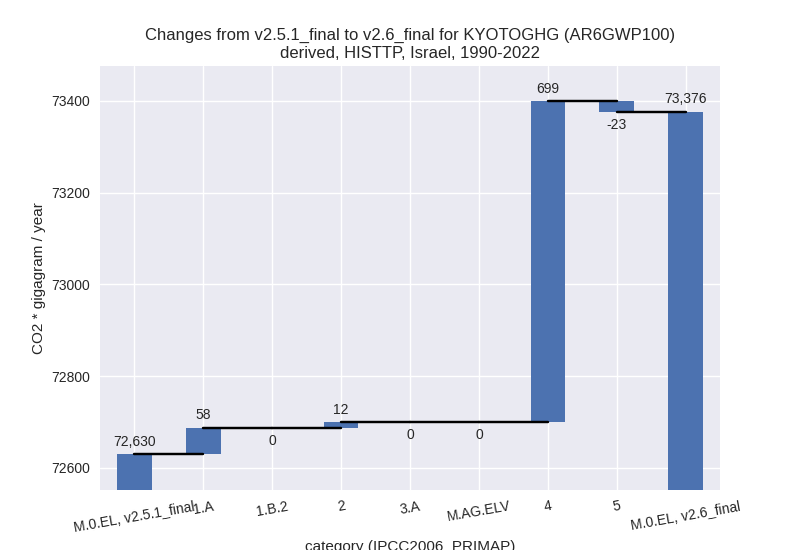
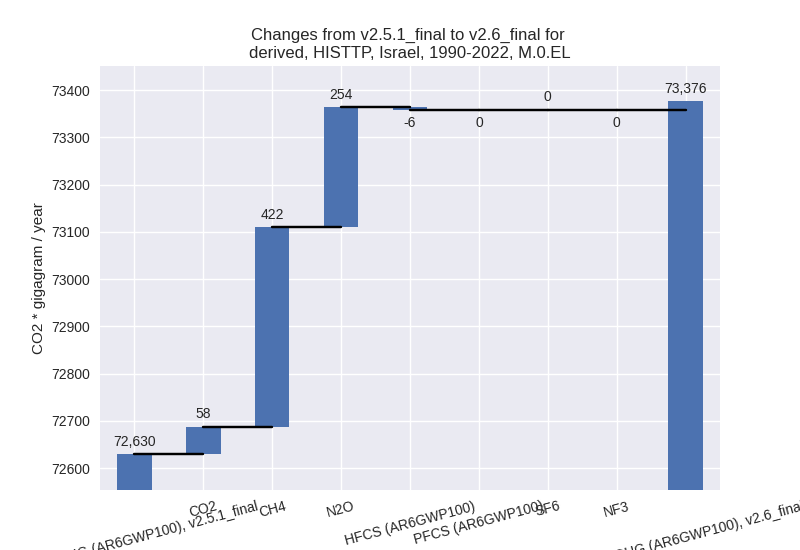
Detailed changes for the scenarios:
country reported scenario (HISTCR):
Most important changes per time frame
For 2022 the following sector-gas combinations have the highest absolute impact on national total KyotoGHG (AR6GWP100) emissions in 2022 (top 5):
- 1: 1.A, CO2 with 1433.18 Gg CO2 / year (2.3%)
- 2: 2, HFCS (AR6GWP100) with 333.80 Gg CO2 / year (4.0%)
- 3: 5, N2O with -34.22 Gg CO2 / year (-10.4%)
- 4: 2, PFCS (AR6GWP100) with -25.62 Gg CO2 / year (-9.6%)
- 5: 2, SF6 with 17.92 Gg CO2 / year (12.2%)
For 1990-2022 the following sector-gas combinations have the highest absolute impact on national total KyotoGHG (AR6GWP100) emissions in 1990-2022 (top 5):
- 1: 1.A, CO2 with 61.39 Gg CO2 / year (0.1%)
- 2: 2, N2O with -43.72 Gg CO2 / year (-7.0%)
- 3: 5, N2O with -22.90 Gg CO2 / year (-6.8%)
- 4: 4, CH4 with -20.09 Gg CO2 / year (-0.3%)
- 5: 2, HFCS (AR6GWP100) with 10.12 Gg CO2 / year (0.5%)
Changes in the main sectors for aggregate KyotoGHG (AR6GWP100) are
- 1: Total sectoral emissions in 2022 are 71492.51 Gg
CO2 / year which is 74.8% of M.0.EL emissions. 2022 Emissions have
changed by 2.0% (1433.18 Gg CO2 /
year). 1990-2022 Emissions have changed by 0.1% (61.39 Gg CO2 / year). For 2022 the
changes per gas
are:
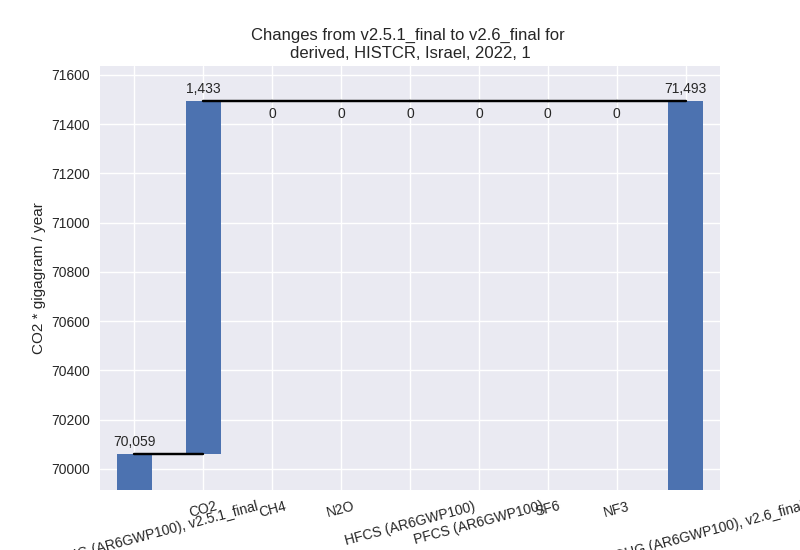
The changes come from the following subsectors:- 1.A: Total sectoral emissions in 2022 are 65256.37
Gg CO2 / year which is 91.3% of category 1 emissions. 2022 Emissions
have changed by 2.2% (1433.18 Gg CO2
/ year). 1990-2022 Emissions have changed by 0.1% (61.39 Gg CO2 / year). For 2022 the
changes per gas
are:
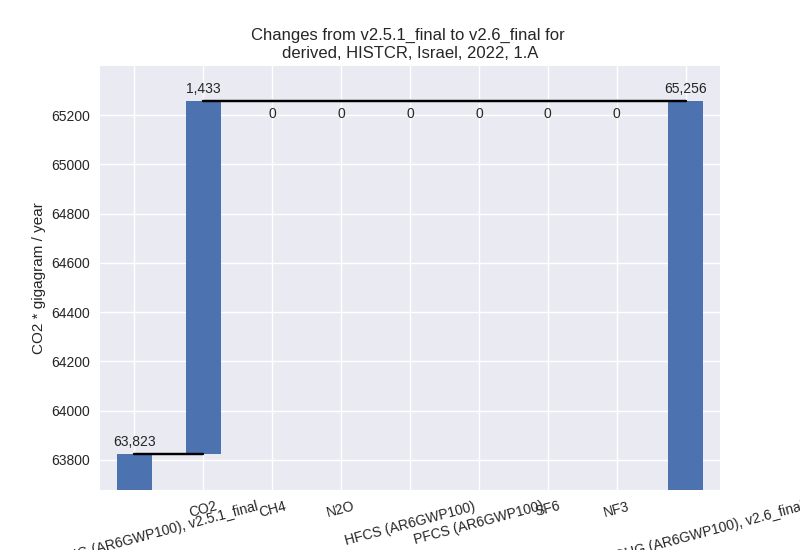
There is no subsector information available in PRIMAP-hist. - 1.B.2: Total sectoral emissions in 2022 are 6236.14 Gg CO2 / year which is 8.7% of category 1 emissions. 2022 Emissions have changed by 0.0% (0.00 Gg CO2 / year). 1990-2022 Emissions have changed by 0.0% (0.00 Gg CO2 / year).
- 1.A: Total sectoral emissions in 2022 are 65256.37
Gg CO2 / year which is 91.3% of category 1 emissions. 2022 Emissions
have changed by 2.2% (1433.18 Gg CO2
/ year). 1990-2022 Emissions have changed by 0.1% (61.39 Gg CO2 / year). For 2022 the
changes per gas
are:
- 2: Total sectoral emissions in 2022 are 12327.94 Gg
CO2 / year which is 12.9% of M.0.EL emissions. 2022 Emissions have
changed by 2.8% (331.34 Gg CO2 /
year). 1990-2022 Emissions have changed by -0.5% (-28.96 Gg CO2 / year). For 2022 the
changes per gas
are:
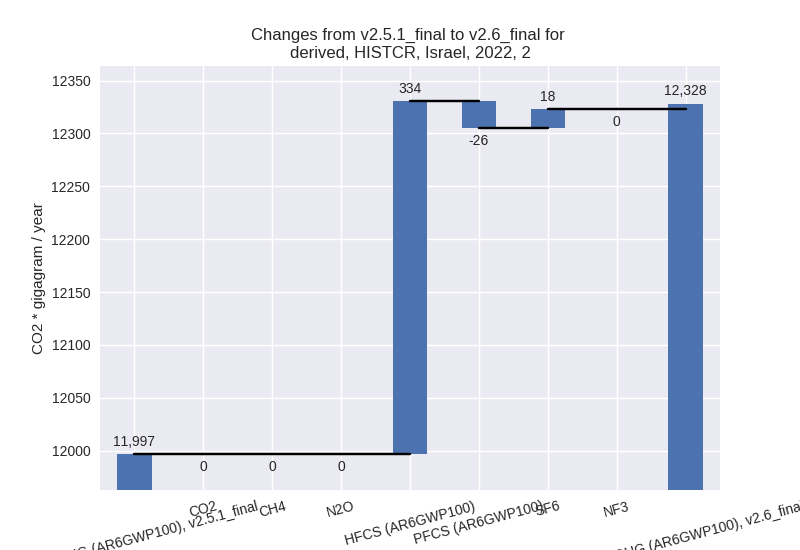
- M.AG: Total sectoral emissions in 2022 are 2578.03 Gg CO2 / year which is 2.7% of M.0.EL emissions. 2022 Emissions have changed by 0.0% (0.00 Gg CO2 / year). 1990-2022 Emissions have changed by 0.0% (0.00 Gg CO2 / year).
- 4: Total sectoral emissions in 2022 are 8881.02 Gg CO2 / year which is 9.3% of M.0.EL emissions. 2022 Emissions have changed by 0.0% (4.39 Gg CO2 / year). 1990-2022 Emissions have changed by -0.3% (-20.76 Gg CO2 / year).
- 5: Total sectoral emissions in 2022 are 293.93 Gg
CO2 / year which is 0.3% of M.0.EL emissions. 2022 Emissions have
changed by -10.4% (-34.22 Gg CO2 /
year). 1990-2022 Emissions have changed by -6.8% (-22.90 Gg CO2 / year). For 2022 the
changes per gas
are:
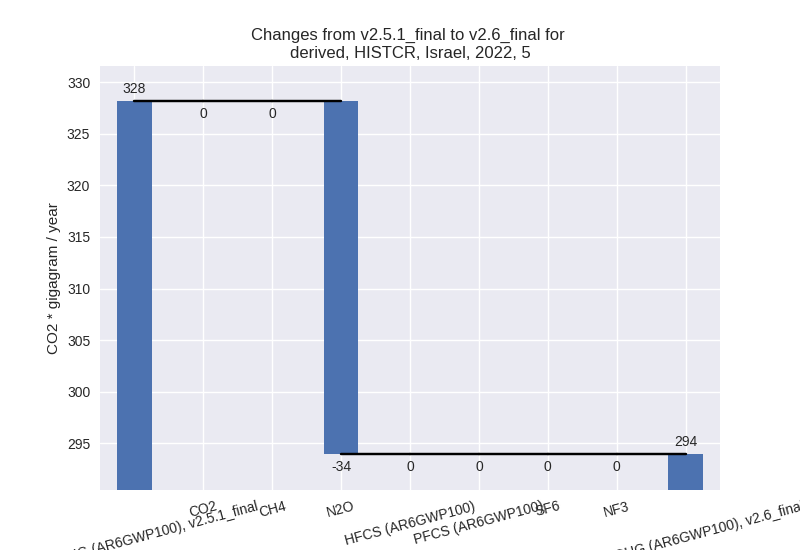
For 1990-2022 the changes per gas are: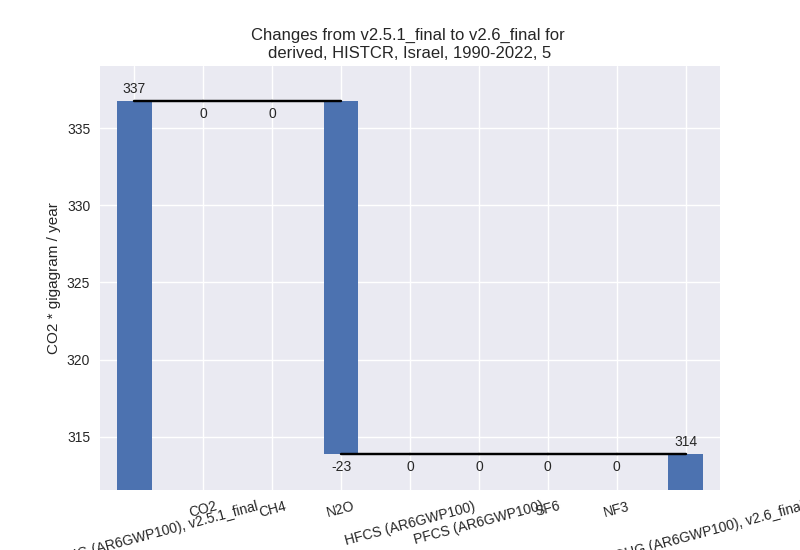
third party scenario (HISTTP):
Most important changes per time frame
For 2022 the following sector-gas combinations have the highest absolute impact on national total KyotoGHG (AR6GWP100) emissions in 2022 (top 5):
- 1: 1.A, CO2 with 1353.90 Gg CO2 / year (2.3%)
- 2: 4, CH4 with 725.81 Gg CO2 / year (9.8%)
- 3: 4, N2O with 393.65 Gg CO2 / year (130.0%)
- 4: 2, HFCS (AR6GWP100) with -185.79 Gg CO2 / year (-2.9%)
- 5: 5, N2O with -34.22 Gg CO2 / year (-10.4%)
For 1990-2022 the following sector-gas combinations have the highest absolute impact on national total KyotoGHG (AR6GWP100) emissions in 1990-2022 (top 5):
- 1: 4, CH4 with 421.95 Gg CO2 / year (7.4%)
- 2: 4, N2O with 277.22 Gg CO2 / year (124.9%)
- 3: 1.A, CO2 with 57.99 Gg CO2 / year (0.1%)
- 4: 5, N2O with -22.90 Gg CO2 / year (-6.8%)
- 5: 2, HFCS (AR6GWP100) with -5.63 Gg CO2 / year (-0.3%)
Changes in the main sectors for aggregate KyotoGHG (AR6GWP100) are
- 1: Total sectoral emissions in 2022 are 68035.51 Gg
CO2 / year which is 76.5% of M.0.EL emissions. 2022 Emissions have
changed by 2.0% (1353.90 Gg CO2 /
year). 1990-2022 Emissions have changed by 0.1% (57.99 Gg CO2 / year). For 2022 the
changes per gas
are:

The changes come from the following subsectors:- 1.A: Total sectoral emissions in 2022 are 61799.37
Gg CO2 / year which is 90.8% of category 1 emissions. 2022 Emissions
have changed by 2.2% (1353.90 Gg CO2
/ year). 1990-2022 Emissions have changed by 0.1% (57.99 Gg CO2 / year). For 2022 the
changes per gas
are:
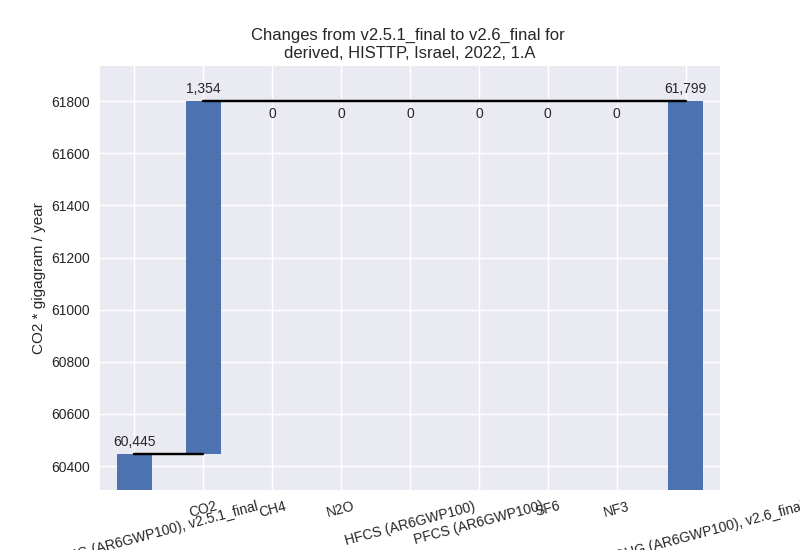
There is no subsector information available in PRIMAP-hist. - 1.B.2: Total sectoral emissions in 2022 are 6236.14 Gg CO2 / year which is 9.2% of category 1 emissions. 2022 Emissions have changed by 0.0% (0.00 Gg CO2 / year). 1990-2022 Emissions have changed by 0.0% (0.00 Gg CO2 / year).
- 1.A: Total sectoral emissions in 2022 are 61799.37
Gg CO2 / year which is 90.8% of category 1 emissions. 2022 Emissions
have changed by 2.2% (1353.90 Gg CO2
/ year). 1990-2022 Emissions have changed by 0.1% (57.99 Gg CO2 / year). For 2022 the
changes per gas
are:
- 2: Total sectoral emissions in 2022 are 9678.65 Gg CO2 / year which is 10.9% of M.0.EL emissions. 2022 Emissions have changed by -1.6% (-161.25 Gg CO2 / year). 1990-2022 Emissions have changed by 0.2% (12.28 Gg CO2 / year).
- M.AG: Total sectoral emissions in 2022 are 2107.84 Gg CO2 / year which is 2.4% of M.0.EL emissions. 2022 Emissions have changed by 0.0% (0.00 Gg CO2 / year). 1990-2022 Emissions have changed by 0.0% (0.00 Gg CO2 / year).
- 4: Total sectoral emissions in 2022 are 8860.36 Gg
CO2 / year which is 10.0% of M.0.EL emissions. 2022 Emissions have
changed by 14.5% (1119.45 Gg CO2 /
year). 1990-2022 Emissions have changed by 11.9% (699.17 Gg CO2 / year). For 2022 the
changes per gas
are:
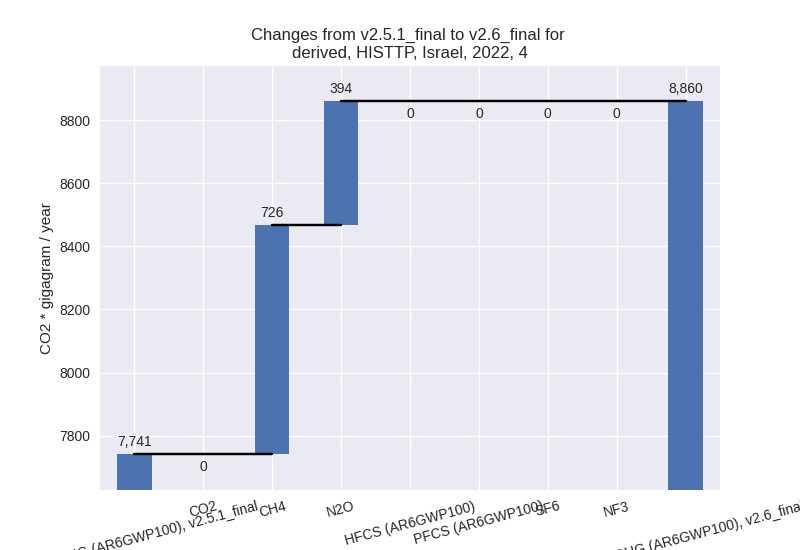
For 1990-2022 the changes per gas are: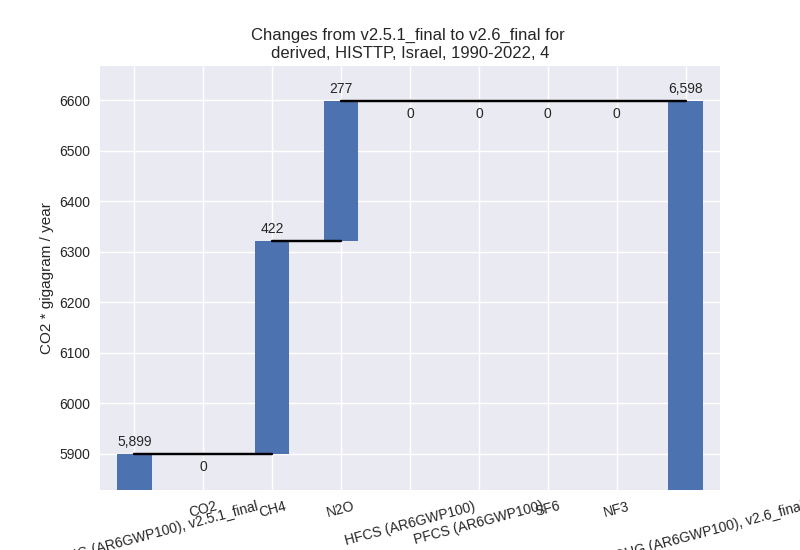
- 5: Total sectoral emissions in 2022 are 293.93 Gg
CO2 / year which is 0.3% of M.0.EL emissions. 2022 Emissions have
changed by -10.4% (-34.22 Gg CO2 /
year). 1990-2022 Emissions have changed by -6.8% (-22.90 Gg CO2 / year). For 2022 the
changes per gas
are:
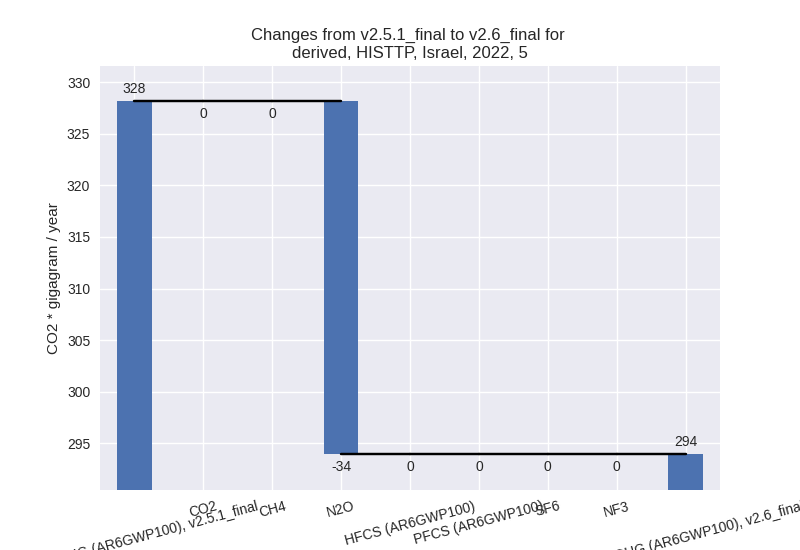
For 1990-2022 the changes per gas are: